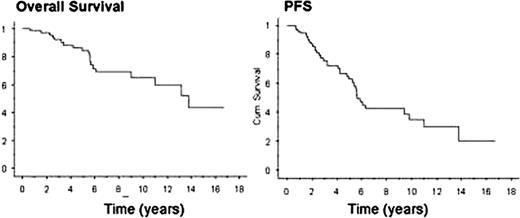Abstract
Abstract 4168
Primary Pulmonary MALT lymphoma represents 15–20% of Extranodal Marginal Zone Lymphomas of Mucosa Associated Lymphoid Tissue (MALT). In contrast to the more common gastric MALT lymphoma, natural history, prognosis and treatment outcomes for primary pulmonary MALT lymphoma are not well defined. Herein, we report a single institution experience.
Consecutive patients with primary pulmonary MALT lymphoma registered in the Mayo Clinic Lymphoma Database, which includes all consenting patients with lymphoma seen at Mayo Clinic Rochester, were reviewed for clinical features, treatment outcome progression free survival (PFS) and overall survival (OS). The pathology for all patients was centrally reviewed by hematopathologist and the diagnoses were based on WHO lymphoma classification criteria. PFS and OS were assessed using the Kaplan–Meier method and the Cox proportional hazard model was used to assess the impact of variables on PFS and OS.
Between December 1986 and June of 2009, ninety-seven patients with primary pulmonary MALT lymphoma were enrolled. The median age at diagnosis was 63 years (range 31–87). There were 43 (44%) males. The initial presentation was a unilateral pulmonary lesion (n=47, 48%), bilateral pulmonary lesions (n=41, 42%), and pulmonary lesion with intrathoracic lymphadenopathy (n= 4, 4%). Bone marrow involvement and presence of B symptoms were 4, 4% and 5, 5%, respectively. International Prognostic Index (IPI) was 0–1, 2–3 and 4–5 in 69, 25 and 1 patient(s) respectively. The median follow-up was 10.4 years. The estimated median OS was 13. 6 years and the median PFS was 5.5 years (Figure). In a multivariate analysis, age >60 (p=0.02) and ECOG PS>2 (p=0.01) were associated with shortened survival. The IPI and age adjusted IPI were not predictive of overall survival. The treatment outcomes for the most common treatment modalities are summarized in the Table below. The median PFS of the 38% of patients who had a complete surgical resection was excellent at 11.2 years; whereas for observed patients with residual disease after biopsy was 3.2 years. Only 8 patients received single agent rituximan with relatively low response rate.
| Treatment . | N (%) . | Response rate CR and CRu/PR n (%) . | Median PFS (years) . |
|---|---|---|---|
| Complete resection | 37 (38%) | 37 (100%)/0 | 11.2 |
| Observation | 17 (18%) | NA | 3.2 |
| Rituximab | 8 (9%) | 0/1 (13%) | 3.8 |
| Chemotherapy | 14 (15%) | 7 (50%)/6 (43%) | 5.3 |
| Chemotherapy and Rituximab | 8 (9%) | 4 (50%)/3 (38%) | NR - 55% at 8 years |
| Radiation | 2 (2%) | 2 (100%)/0 | NA |
| Combined modality or missing details | 11 (11%) | NA | 6.1 |
| Treatment . | N (%) . | Response rate CR and CRu/PR n (%) . | Median PFS (years) . |
|---|---|---|---|
| Complete resection | 37 (38%) | 37 (100%)/0 | 11.2 |
| Observation | 17 (18%) | NA | 3.2 |
| Rituximab | 8 (9%) | 0/1 (13%) | 3.8 |
| Chemotherapy | 14 (15%) | 7 (50%)/6 (43%) | 5.3 |
| Chemotherapy and Rituximab | 8 (9%) | 4 (50%)/3 (38%) | NR - 55% at 8 years |
| Radiation | 2 (2%) | 2 (100%)/0 | NA |
| Combined modality or missing details | 11 (11%) | NA | 6.1 |
The prognosis of primary pulmonary MALT lymphoma is favorable, with a median survival of over 13 years. In patients with resectable disease, surgery alone is associated with excellent disease control. Further prospective studies are needed to define the optimal treatment of primary pulmonary MALT lymphoma.
No relevant conflicts of interest to declare.
Author notes
Asterisk with author names denotes non-ASH members.


This feature is available to Subscribers Only
Sign In or Create an Account Close Modal